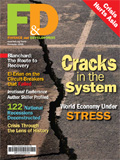 View this Issue Archive of F&D Issues Subscribe to Print Edition United States and the IMF United States and the IMF Write to us F&D welcomes comments and brief letters, a selection of which are posted under Letters to the Editor. Letters may be edited. Please send your letters to: fanddletters@imf.org. F&D Magazine Free Email Notification Receive emails when we post new
items of interest to you. |
A reassessment of emerging economies' growth prospects has fundamentally changed the outlook for commodity markets The commodity price boom is over. The collapse in prices since the renewed global financial turmoil began has ended any hope that commodity prices might remain close to their recent peaks. With hindsight, the sharp drop in commodity prices should not come as a surprise. The financial turmoil has intensified and spread to emerging economies. A sharp global downturn now seems inevitable and will involve growth below trend in emerging and developing economies in 2009, not just the return back to trend that had been earlier expected. Indeed, recent data confirm that activity in emerging and developing economies is decelerating rapidly. This reassessment of emerging economies' growth prospects has fundamentally changed the outlook for commodity markets. These economies have accounted for the bulk of incremental demand for most commodities in recent years. Cracks appear Financial turmoil has accelerated the downward price momentum, as investors have reduced holdings of commodity assets for a number of reasons. This reduction has fed into commodity futures markets, where financial intermediaries hedge their over-the-counter market exposure. The decline in demand for long futures positions has coincided with increasing demand for short positions by producers. Downward pressure on net long positions in commodity futures markets has also arisen from a lack of credit for leveraged commodity market exposure (e.g., by hedge funds), increasing preference for liquidity by many investors, and the sizable recent appreciation of the U.S. dollar in nominal effective terms. What will affect commodity prices? Current price levels already reflect much lower expected global growth. Nevertheless, past experience with global downturns suggests that we might see further declines. In the near term, commodity supply is generally price inelastic, and downward pressure from contracting demand dominates in downturns. Within this broad trend, what factors will influence the trend in prices? The severity of the global downturn will be a factor. Key issues are how much emerging economies will be affected overall and how much their investment demand will slow. Consider metals prices. China accounted for almost all of the incremental demand for key metals over the past year and a half. Therefore, much will depend on how much credit constraints will lower financing for investment projects and how much fiscal stimulus could boost infrastructure development and support metals demand. Second, supply retrenchment could provide for some upside price potential. In the short term, this possibility seems most relevant for commodities with uncompetitive supply structures. Until recently, markets discounted the recent decision by the Organization of the Petroleum Exporting Countries (OPEC) to cut crude oil production by 1.5 million barrels a day. Weaker oil demand The backdrop to market skepticism is that global oil demand will be much weaker than expected and will most likely contract in 2009, a first since the 1980-82 downturn. Barring an unexpected drop in non-OPEC production, OPEC will likely have to cut production further to stabilize prices. This raises the perennial question of whether OPEC discipline will hold up, given members' need for oil revenue. Third, the impact of the expected global downturn on prices should vary across commodities, given differences in income elasticities. Food prices in particular are likely to be less affected by changes in global growth prospects. Resolution of weather-related supply disruptions in the current crop year and the removal of export restrictions have been the main factor behind the substantial easing of food prices. Lower energy prices will eventually lead to some further easing. Risks are, however, that the high fuel and fertilizer prices through mid-2008 in conjunction with the credit crunch may temporarily weigh on supply in 2009. It takes two to contango Over the past few months, futures prices of many commodities have declined by much less than spot prices and are now considerably higher than the latter. This so-called "contango" constellation implies that prices are expected to rise over the next few years, otherwise there would be arbitrage opportunities. Indeed, empirical evidence for oil futures prices suggests that current spreads between futures and spot prices provide reliable signals for the direction of change in oil prices in the future. The price rebound might not just reflect the recovery of global demand. On the supply side, current low spot prices will further slow capacity expansion for many commodities. Indeed, investment projects in high-cost oil fields and mines are beginning to be cancelled or postponed because they do not break even at current prices. Hence, capacity constraints for key commodities might reemerge. Nevertheless, a rebound in prices would not mean that prices will again reach the levels seen earlier this year any time soon. It is also important to keep the high commodity price volatility in mind.
|